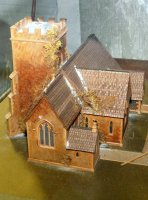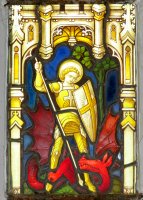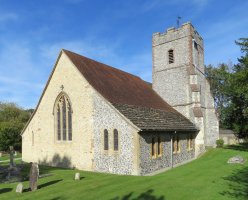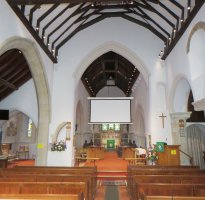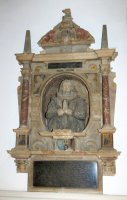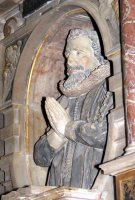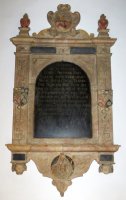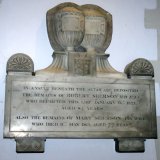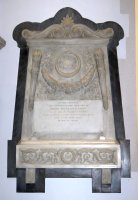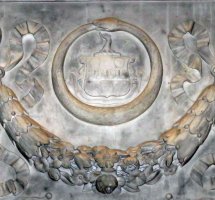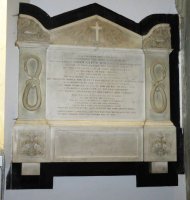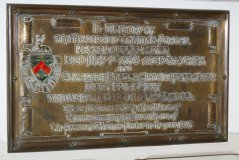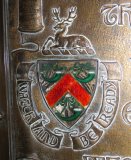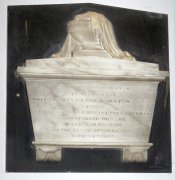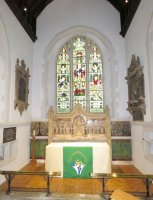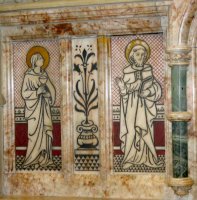Fetcham Church monuments
St Mary Fetcham, Surrey, is a charming, small church of very ancient date, containing some half a dozen carved panel monuments and a few modern brasses. Click any picture to enlarge, or hover for caption.
St Mary's Church, Fetcham, is built of a pleasing mix of flint, pale stone, and reused Roman bricks. There is a buttressed three stage tower with battlements, and the roof, sweeping down over the aisles, is a notable feature. Much of the Church is of the 12th Century; one small window reconstructed with Roman brick, and part of the nave (especially the West wall) are likely Saxon. The chancel dates from the 13th Century with a 15th Century East window, and the tower is a replacement from the 17th and 18th centuries, though reusing earlier material in the buttresses.
Fetcham Church.
Inside, the roof is open, and great pointed arches open up the interior, raised on thick stone pillars. The features of the Church are its look, and age, and ambience, rather than the few monuments, however they are of some interest, including a 17th Century bust and work by the sculptors Sievier and Rouw, and a minor piece by J.E. Thomas. We take them in date order.
Monuments
Henry Vincent, d.1631, with a rhyming epitaph. His carved portrait half-statue looks straight out at the viewer from within a deep oval niche. His face is rather craggy, with prominent cheekbones, a broad, intelligent forehead, and a slightly sad expression. His hair is ringleted, and he has a full moustache and a trimmed beard above his broad ruff. He has a big-shouldered cloak over a buttoned shirt, all black painted, and his hands are raised in prayer above an open book on a shelf in front of him. Under the shelf, his painted shield of arms. The niche is within a rectangular panel with spandrels (triangular shapes in the corners) with winged cherub heads carved in relief with a bit more paint and gilt. To the sides are deep red and white marble pillars, with Corinthian capitals, and above, a shelf with projecting sides, supporting obelisks. Between these is his painted, carved coat of arms with knight's helm and mantling; the triangular shape overall looks odd and likely cut down. The inscription is to the base, and to either side, the pillar supports are carved with charming little heads with wavy hair.
Anthony Rous, and the skeleton.
Anthony Rous, d.1631, with a Latin inscription. Dark, oval inscribed panel within a carved alabaster surround. To the sides, painted shields of arms, and behind these, carved in low relief, a variety of ribbons, books, etc. Little flowers above, and an upper shelf on which rests a central arms within a sort of cartouche with scrolling, and, less usually, little hearts to the sides. Beneath the lower shelf, a central memento mori: the upper part of a skeleton, wearing a shroud, and holding in one hand an arrow of mortality, and in the other, an hourglass to show time running out (picture above right, click to enlarge). The drapery loops round to for ma knot at the base. The side supports are small winged cherub heads. A very good and very characteristic piece of its era.
John Jervis Brenton, d.1817, eldest son of Sir Jahleel Brenton, Baronet. Plain panel cut to a casket-end shape, with repeating pattern above the inscription, on a shaped black panel.
Sculptor Rouw's double pots to Robert and Mary Sherson..
Robert Sherson, d.1821, and his wife Mary Sherson, d.1815. With a pair of overlapping pots carved in high relief on top, small shield of arms, and semicircular acroteria ('ears') with anthemion designs to the sides. The panel has two block supports with tiny scrolls on them, one signed by Peter Rouw, 'sculptor, modeller to his Majesty, New Road, London'. Crisply cut, as always by this significant monument maker. He uses the same double-pot motif on a more ambitious panel to John Hyde in Mitcham Church.
John Bolland, d.1829. A vertical-format white-on-black panel of more than usual sculptural ornament. Above the inscription, a snake swallows its tail, above a festoon of carved flowers held by ribbons at the top, with flaming torches to the sides. Above, a shelf with swan-necked (scrolly) pediment, and below, a thick shelf with stylised leaves beside a central wreath, and another pair of wiggly snakes. Supported on leafy brackets, and the black backing panel is closely shaped to the outline of the front panel, giving it an unusual silhouette above. This excellent work is by the monumental sculptor Robert Sievier.
Bolland panels, by sculptor R. Sievier.
The Revd. John Gipps Bolland, d.1833, Rector of the Church, erected by his wife and sisters. Another work by Sievier. Styled as a tomb chest end, with upper pediment and acroteria, willfully chunky, the centre bearing a cross in front of a sunburst, the sides as simple pilasters (flat pillars), each with an elegantly coiled snake carved in high relief. Under these, stylised flowers, and a blank central portion, and on a shaped black backing.
The Revd. Fetcham, d.1836.
The Revd. Thomas Foster, d.1836, Rector, and his sister Elizabeth Foster, d.1837, erected by his grandchildren in 1907. A coppery panel, with nice Arts and Crafts lettering, relief scrolling to the sides, and a shield of arms in red and green enamel. A good thing.
John Hopper, d.1839.
John Thomas Henrie Hopper, d.1839. A nice casket end, with draped pot on the lid, and curled-leaf feet. Signed on the black backing panel by J.E. Thomas, London. This is the Welsh sculptor John Evan Thomas, who as well as making a fair number of church monuments, has several public statues to his name, including the Marquis of Bute for Cardiff, and Prince Albert for Tenby.
Sir George Henry Richards, d.1896, who 'devoted a long life with great ability and unswerving purpose to the service of his country and the advancement of Hydrographic knowledge and the development of submarine telegraphy', also noting he went to the Arctic in search of Franklin. Typical example of a modern brass, with black capitals, the chief ones picked out in red, and a border of repeating design, here a particularly nice design of flowers and leaves. Mounted on a strikingly coloured marble backing panel.
George Herbert Newton, d.1947, Rector, a plain unornamented stone.
Henry Vincent monument.
Also in the Church
The ancient window made of Roman brick, round headed, perhaps around the time of the Norman conquest.
15th Century piscina.
A painted Royal Coat of arms on wood.
Some very good 19th Century tiling on the floor, with designs taken from medieval work and reproduced in the crisp encaustic wares of Victorian times. If you click to enlarge the picture of the chancel below left, you can see these tiles.
A good model of the Church, made by Alfred White, 1874.
Stained glass including a St George and the Dragon - see picture at top of page.
The Arts and Crafts altarpiece (reredos).
The rather excellent Arts and Crafts altarpiece, of alabaster and tile, with rendering in outline of various saints, the sacrifice of Isaac, etc, and with nice green tiles below.
Finally, outside, the Churchyard contains a few interesting pieces, including 18th Century work, rather battered, and a great granite tomb styled as a coffin with great brass rings and a cross on top, raised on steps, to a London Lord Mayor, Sir Francis Graham Moon, d.1871. Note too the charming steep-roofed lych gate, pictured below.
The Church website is at https://stmarysfetcham.org.uk/new-to-st-marys/our-church/.
